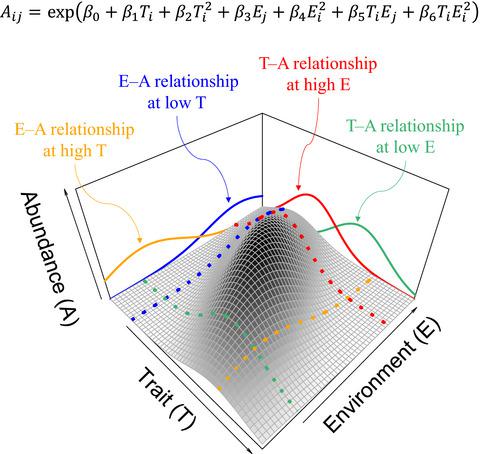Our official English website, www.x-mol.net, welcomes your
feedback! (Note: you will need to create a separate account there.)
Complex trait‒environment relationships underlie the structure of forest plant communities
Journal of Ecology ( IF 5.3 ) Pub Date : 2021-08-05 , DOI: 10.1111/1365-2745.13757 Andres G. Rolhauser 1, 2, 3 , Donald M. Waller 4 , Caroline M. Tucker 1, 5
中文翻译:

复杂的性状-环境关系是森林植物群落结构的基础
更新日期:2021-08-05
Journal of Ecology ( IF 5.3 ) Pub Date : 2021-08-05 , DOI: 10.1111/1365-2745.13757 Andres G. Rolhauser 1, 2, 3 , Donald M. Waller 4 , Caroline M. Tucker 1, 5
Affiliation

|
- Traits differentially adapt plant species to particular conditions generating compositional shifts along environmental gradients. As a result, community-scale trait values show concomitant shifts, termed trait‒environment relationships. Trait‒environment relationships are often assessed by evaluating community-weighted mean (CWM) traits observed along environmental gradients. Regression-based approaches (CWMr) assume that local communities exhibit traits centred at a single optimum value and that traits do not covary meaningfully. Evidence suggests that the shape of trait‒abundance relationships can vary widely along environmental gradients—reflecting complex interactions—and traits are usually interrelated. We used a model that accounts for these factors to explore trait‒environment relationships in herbaceous forest plant communities in Wisconsin (USA).
- We built a generalized linear mixed model (GLMM) to analyse how abundances of 185 species distributed among 189 forested sites vary in response to four functional traits (vegetative height—VH, leaf size—LS, leaf mass per area—LMA and leaf carbon content), six environmental variables describing overstorey, soil and climate conditions, and their interactions. The GLMM allowed us to assess the nature and relative strength of the resulting 24 trait‒environment relationships. We also compared results between GLMM and CWMr to explore how conclusions differ between approaches.
- The GLMM identified five significant trait‒environment relationships that together explain ~40% of variation in species abundances across sites. Temperature appeared as a key environmental driver, with warmer and more seasonal sites favouring taller plants. Soil texture and temperature seasonality affected LS and LMA; seasonality effects on LS and LMA were nonlinear, declining at more seasonal sites. Although often assumed for CWMr, only some traits under certain conditions had centred optimum trait‒abundance relationships. CWMr more liberally identified (13) trait‒environment relationships as significant but failed to detect the temperature seasonality‒LMA relationship identified by the GLMM.
- Synthesis. Although GLMM represents a more methodologically complex approach than CWMr, it identified a reduced set of trait‒environment relationships still capable of accounting for the responses of forest understorey herbs to environmental gradients. It also identified separate effects of mean and seasonal temperature on LMA that appear important in these forests, generating useful insights and supporting broader application of GLMM approach to understand trait‒environment relationships.
中文翻译:

复杂的性状-环境关系是森林植物群落结构的基础
- 性状使植物物种不同地适应特定条件,从而产生沿环境梯度的成分变化。因此,社区规模的特征值显示出伴随的变化,称为特征-环境关系。通常通过评估沿环境梯度观察到的社区加权平均 (CWM) 性状来评估性状-环境关系。基于回归的方法 (CWMr) 假设当地社区表现出以单一最佳值为中心的特征,并且特征不会有意义地共变。有证据表明,性状-丰度关系的形状可以随环境梯度变化很大——反映了复杂的相互作用——并且性状通常是相互关联的。
- 我们建立了一个广义线性混合模型 (GLMM) 来分析分布在 189 个林地中的 185 个物种的丰度如何响应四个功能性状(植物高度 - VH,叶片大小 - LS,单位面积叶片质量 - LMA 和叶片碳含量) ),六个环境变量描述了层高、土壤和气候条件,以及它们之间的相互作用。GLMM 使我们能够评估由此产生的 24 个特征-环境关系的性质和相对强度。我们还比较了 GLMM 和 CWMr 之间的结果,以探讨不同方法之间的结论有何不同。
- GLMM 确定了五个重要的性状-环境关系,它们共同解释了约 40% 的跨站点物种丰度变化。温度似乎是一个关键的环境驱动因素,温暖和季节性更强的地点有利于较高的植物。土壤质地和温度季节性影响 LS 和 LMA;对 LS 和 LMA 的季节性影响是非线性的,在更多的季节性地点下降。尽管通常为 CWMr 假设,但只有某些条件下的某些性状具有中心最优性状-丰度关系。CWMr 更自由地将 (13) 特征-环境关系确定为显着,但未能检测到 GLMM 确定的温度季节性-LMA 关系。
- 合成。尽管 GLMM 代表了一种比 CWMr 在方法论上更复杂的方法,但它确定了一组减少的性状-环境关系,仍然能够解释森林下层草本植物对环境梯度的响应。它还确定了平均和季节性温度对 LMA 的不同影响,这些影响在这些森林中显得很重要,产生了有用的见解并支持更广泛地应用 GLMM 方法来理解性状-环境关系。











































 京公网安备 11010802027423号
京公网安备 11010802027423号